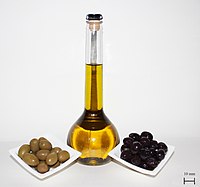
Photo from wikipedia
ABSTRACT The high cost of the bridging liquid subdues the implementation and commercialization of oil agglomeration process. To overcome this problem, waste oils from different sectors were used in this… Click to show full abstract
ABSTRACT The high cost of the bridging liquid subdues the implementation and commercialization of oil agglomeration process. To overcome this problem, waste oils from different sectors were used in this present study. The performance of the process was assessed based on the responses like ash rejection and organic matter recovery. The aim of the present study was to investigate the usage of waste oils from different sectors and to optimize and analyze the behavioral pattern showcased by different variables (pulp density, oil dosage, agglomeration time and oil type) using response surface methodology (Box-Behnken design). Experimental investigation shows that the optimum pulp density, oil dosage, agglomeration time and oil type condition obtained as 3%, 15%, 15 min and waste engine oil, respectively. At optimum condition, the % ash rejection and % organic matter recovery obtained as 63.94% and 81.8%, respectively. GRAPHICAL ABSTRACT
Journal Title: Journal of Dispersion Science and Technology
Year Published: 2018
Link to full text (if available)
Share on Social Media: Sign Up to like & get
recommendations!